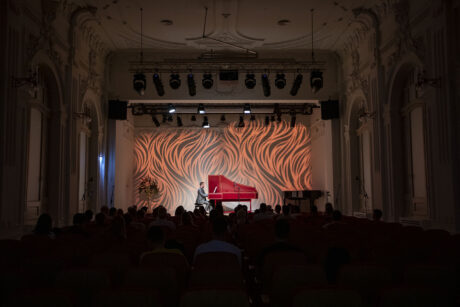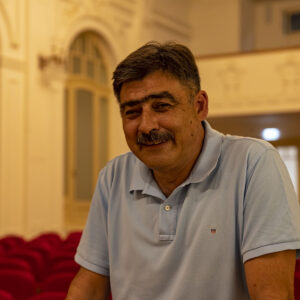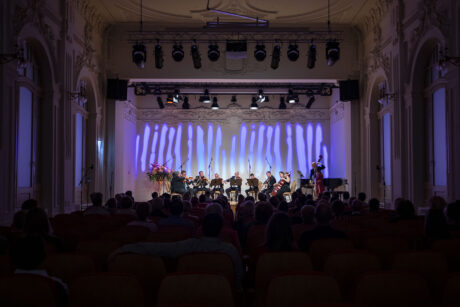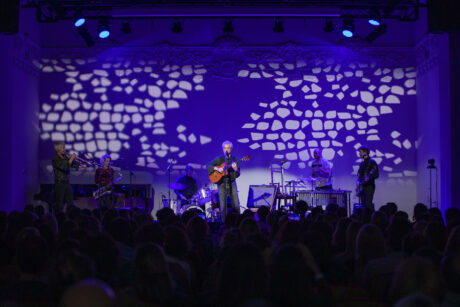 The 256-capacity Concert Hall at the Hrvatski Dom in Split, Croatia’s second city and vibrant cultural hub, is enjoying new Robe T1 Profile moving lights as part of a technical investment that was initiated and specified by the venue’s head of technical, Slaven Tahirbegovic.
The 256-capacity Concert Hall at the Hrvatski Dom in Split, Croatia’s second city and vibrant cultural hub, is enjoying new Robe T1 Profile moving lights as part of a technical investment that was initiated and specified by the venue’s head of technical, Slaven Tahirbegovic.
The fixtures were delivered by Robe’s Croatian distributor LAV Studio and installed when the building re-opened after extensive renovations which returned the Art Nouveau architecture and décor back to its original 1908 splendor simultaneously integrating contemporary elements enabling it to function fully as a cool 21st century performance space. They join the existing 10 Robe LEDWash 600s which were delivered in late 2019, a great combination of fixtures to facilitate the current program of shows and events.
 The Concert Hall is an intimate and beautiful space. It has outstanding acoustics and is utilized for classical, jazz, acoustic and unplugged concerts, and broadcasts. The venue also regularly hosts premium conferences and presentations. Typically, 10 or 12 shows a month are staged there, boosted to daily performances during Split’s famous Summer Festival which runs for a month from mid-July to mid-August.
The Concert Hall is an intimate and beautiful space. It has outstanding acoustics and is utilized for classical, jazz, acoustic and unplugged concerts, and broadcasts. The venue also regularly hosts premium conferences and presentations. Typically, 10 or 12 shows a month are staged there, boosted to daily performances during Split’s famous Summer Festival which runs for a month from mid-July to mid-August.
During the pandemic, the Concert Hall’s first ‘new season’ streamed program in 2021 attracted over 30,000 online visitors. To make up for doors being close to the public during that time – and previously due to the building works – in 2022 it has staged the most concerts of any Concert Hall in Croatia, so the new lights came at an opportune moment.

Before taking up his post at Hrvatski Dom, Tahirbegovic worked for over 26 years at HRT (Croatian Radio Television) and for five years in different high-profile technical, broadcasting and consulting capacities in Qatar, which included government projects and three stadiums as a broadcast consultant and systems integrator. Already familiar with Robe as a brand, this is where he first met the T1 Profile.
After returning to Croatia to start the job and as the renovation neared completion, he started looking for new lights for the Concert Hall. “The T1 Profile is very quiet – essential for a concert hall,” he said, adding that he likes the amazing quality of light output and the excellent range of color correction whites. “It’s an excellent piece of kit that just works on all levels – and it is as simple as that.” From a technical standpoint, reliability was critical. The T1 Profiles and the LEDWash 600s are used constantly for key lighting and to throw dynamic gobo patterns onto the back wall which is highly effective.
 There is a ChamSys lighting console for control and most of the shows are lit by the in-house team which includes a part-time lighting designer on the staff. All the Hrvatski Dom lighting technical support and services are coordinated via LAV Studio whose Emil Koller commented, “For us the Concert Hall is a key reference, and we are very proud to be working with Tahirbegovic and his team, we enjoy a solid and long-term relationship.” Tahirbegovic underlines the importance of having “solid technical support, which is a priority for any busy venue.”
There is a ChamSys lighting console for control and most of the shows are lit by the in-house team which includes a part-time lighting designer on the staff. All the Hrvatski Dom lighting technical support and services are coordinated via LAV Studio whose Emil Koller commented, “For us the Concert Hall is a key reference, and we are very proud to be working with Tahirbegovic and his team, we enjoy a solid and long-term relationship.” Tahirbegovic underlines the importance of having “solid technical support, which is a priority for any busy venue.”
About the Building
The current Hrvatski Dom building dates to 1908 and has a colorful history. The idea of building a “Croatian home” first appeared in 1896 to unite Split’s folk cultural, artistic and sports societies – the National Reading Room, Slavic Progress, Folk Music, Volunteer Firefighters, Musical Society “Zvonimir” and gymnastic society (Hrvatski Sokol).
 The building design was created in the spirit of Art Nouveau architecture, built according to architect Kamilo Tončić’s vision and opened in 1908. It played an important role in Split’s musical community as a meeting place for musicians and a performance venue / Concert Hall until the First World War. After 1929 it was utilized by the Sokol Slavic gymnastic society of Yugoslavia, who founded the Sokol Puppet Theatre in 1933 which became the Pioner Puppet Theatre in 1945 and then the City Puppet theatre of today. The hall was used for various sporting activities during these years and the puppet theatre remains in the building.
The building design was created in the spirit of Art Nouveau architecture, built according to architect Kamilo Tončić’s vision and opened in 1908. It played an important role in Split’s musical community as a meeting place for musicians and a performance venue / Concert Hall until the First World War. After 1929 it was utilized by the Sokol Slavic gymnastic society of Yugoslavia, who founded the Sokol Puppet Theatre in 1933 which became the Pioner Puppet Theatre in 1945 and then the City Puppet theatre of today. The hall was used for various sporting activities during these years and the puppet theatre remains in the building.
In 2005 an initiative was founded to return the Croatian Home to its original appearance. The restoration project started in 2017 and the façade was completed by 2019. In December 2020 the fully rejuvenated Croatian Home and the Concert Hall within it was officially re-opened to the public for all to enjoy.
Further information from Robe lighting: www.robe.cz
Show photos by Maja Prgomet / Venue photos by Louise Stickland


